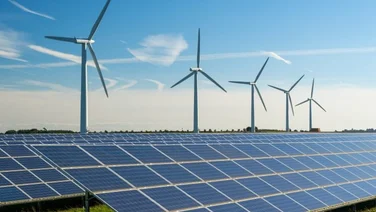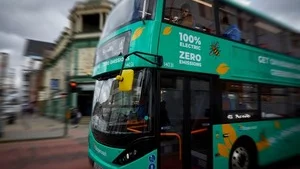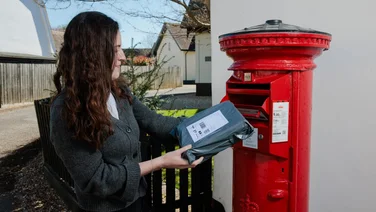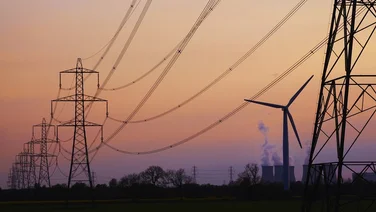- What are solar farms and why does the UK need them?
- Why have solar farms in rural areas divided opinion?
- The case for converting urban areas into solar farms
- Could urban solar farms power a whole city?
- Are other countries converting urban areas into solar farms?
- The pros and cons of converting urban areas into solar farms
- Summary
✔ Unused space in cities can be used for urban solar farms
✔ It’d take 4.6 million solar panels to power London
✔ People who can’t install solar panels can access solar power with urban solar farms
Solar farms have the potential to power our homes using only the light from the sun, making them eco-friendly alternatives to power stations using polluting fossil fuels.
They’re still a contentious issue for some though because they typically take up a lot of green space and can be considered a blight on the landscape.
It makes you wonder why we don’t see more urban areas converted into solar farms. Think about all the abundant car parks we could cover with solar panels to power nearby homes.
To answer this, we’ve discussed below why we should convert more urban areas to solar farms, why rural solar farms are controversial, the pros and cons of urban solar farms, and whether other countries are converting urban areas into solar farms.

What are solar farms and why does the UK need them?
Solar farms are large-scale solar installations that are designed to provide enough electricity to power villages, towns, and even small cities.
They generate much more electricity than residential solar installations, and are far larger in scale. In fact, the biggest solar farms take up thousands of acres and can easily be seen from space. Shotwick solar park, the UK’s biggest solar farm, is 250 acres, and produces 72.2 megawatts (MW) per year.
The UK needs solar farms because we need to stop relying on fossil fuels to provide electricity – and that’s exactly what the UK government is trying to do in its bid to reach net zero emissions by 2050.
We’ve also seen how volatile it can be using fossil fuels to generate electricity recently, after Russia withheld gas supplies to European countries, increasing the price of electricity dramatically.
Unlike fossil fuels, solar is an abundant — and free — source of energy that we should be investing in far more than that we currently are.
Why have solar farms in rural areas divided opinion?
Rural solar farms have become a controversial topic because, for some people, they ruin the pristine view of a green field.
Of course, you could just as easily argue that the damaging effects of climate change will cause more damage to the countryside, but that’s a different debate.
So what’s the solution? For some, it’s creating agrivoltaic farms, where solar panels are installed over farm crops. For others, it’s converting unused areas in towns and cities into urban solar farms.
It’s clear the UK public wants more investment in solar too, as our 2023 National Home Energy Survey showed. Of the 78% of Brits who wanted the UK government to invest in more renewable energy sources, 24% specified solar power.

The case for converting urban areas into solar farms
Urban solar farms solve an issue that’s plagued many eco-conscious homeowners and renters living in built-up cities — installing their own solar panel system with limited space and getting the right permissions to do so.
Many people in cities live in flats or house shares, where accessing solar power is more challenging than it is for homeowners in detached properties.
Space in general is always more limited in urban environments, but that doesn’t mean there aren’t still lots of unused areas.
So why not convert these into solar farms? They’ll provide people with clean solar power and put a dent in the vast quantities of electricity that cities consume.
They’d also work to shrink the carbon emissions of cities, which is massive compared to rural locations. London emitted 31.5 million tonnes of carbon dioxide equivalent in 2019 for example.
What kind of urban areas should be used for solar farms?
The best part about urban solar farms is that you can get really creative with where you place them.
What about on top of an ugly car park? Absolutely — it’s not like they’re cultural landmarks that are legally protected from further development. Plus, putting solar panels on top of car parks would turn an otherwise useless space into one that generates clean electricity.
The obvious choice for solar panels though is rooftops, which take up anywhere between 15% and 35% of a city’s total land area. In London, there are literally thousands of acres of unused rooftop space, which if converted to host solar panels, could provide hundreds of megawatts (MW) of electricity.
There are already 371 acres of rooftop space dedicated to rooftop gardens in London, so why not use some of this space for urban solar farms?
You can also link small-scale solar installations (as long as they’re not residential) together to create a mosaic of solar panels — something Rome has proposed in their 2030 World Expo bid. The concept is pretty wild — linking multiple solar panels over a large stretch of the city, so they all work in tandem.
This is a smart solution for cities because it’d mean they wouldn’t have to allocate one single, large plot of land for an urban solar farm.
Solar trees – artificial trees that are equipped with panels – are also popping up around the city to generate clean energy from the sun. But these new innovations can cost as much as £62,000 per structure.
Could urban solar farms power a whole city?
London consumes an average of 44,000 gigawatt hours (GWh) each year — or 120 GWh each day — meaning it would need roughly 4.6 million solar panels to power it.
That’d require at least 92 million square metres (m²) of space, which sounds like a colossal amount, but it’s worth bearing in mind that London’s total area is 1.569 billion m². This means we’d only need to cover 5.8% of London’s existing land area with solar panels to keep it powered throughout the year.
It’s a challenge for sure, but not completely out of the question if the unused space on rooftops, car parks, and other disused places were utilised.
Are other countries converting urban areas into solar farms?
France passed legislation in 2022 that will require all car parks with more than 80 spaces to be covered by solar panels.
If this happens, it’ll add 11 gigawatts (GW) to the country’s electrical grid, or the equivalent of 10 nuclear reactors. France consumes over 420,000 GWh each year, so these car park solar farms would contribute about 3% of France’s daily electricity needs.
Similarly, the Federal Electricity Commission in Mexico City is building the world’s largest urban solar farm atop the iconic Central de Abasto – the biggest wholesale market on the planet.
If successful, the project will install solar panels on the numerous warehouse and market units, generating 18 megawatts.
The pros and cons of converting urban areas into solar farms
- Provides cities with clean, renewable energy
- Makes use of unused space
- Helps low-income households and renters access clean energy
- Generates green jobs
- Lowers global emissions
- Adds energy resilience
- High upfront cost to install
- Cities still have far less space than rural areas for solar farms
- Solar energy output is weather dependent
- Solar energy storage is expensive
Advantages of urban solar farms
Provides cities with clean, renewable energy
Cities use vast amounts of electricity – far more than rural environments. Adding urban solar farms would help alleviate this energy demand, reducing strain on the grid and lowering the threat of blackouts when demand exceeds supply.
Makes use of unused space
Cities have a surprising amount of unused space that could be used for solar panels. Rooftops, car parks, and pavements can all be turned into mini urban solar farms, which can be connected to create a larger solar network.
Helps low-income households and renters access clean energy
People living in low-income households might be unable to afford or access the benefits of solar panels. Renters too, could struggle to get permission to install solar panels, so both are usually at the mercy of whatever energy suppliers are charging for electricity.
Installing urban solar farms could help reduce low-income families’ energy costs. Additionally, if an urban solar farm was managed by a council, the low cost of solar energy could free up money to be used to assist residents through other programmes.
Generates jobs
Developing solar farms creates local, well-paying green jobs and training opportunities, which will stimulate the economy. Large-scale solar will require maintenance to keep it running smoothly, so there’ll be continuous work long after installation.
The UK has seen a 315% increase in demand for solar installers in 2022, and by 2028 it’s predicted another 10,000 solar jobs would be created.
Lowers global emissions
Urban solar farms will reduce the amount of emissions released into the atmosphere from burning fossil fuels, clearing up air pollution, smog, acid rain, and contaminated water.
An acre of space in a solar farm saves between 267,526 to 303,513 pounds, or 121 to 138 metric tons, of carbon dioxide per year (Lawrence Berkeley National Laboratory, 2022).
Adds energy resilience
Natural disasters, such as floods, wildfires, and mudslides can cause power outages in cities, albeit rarely in the UK at the moment. However, climate change is accelerating, and it’s only a matter of time before these issues become more common.
Urban solar farms help limit the effects of climate change and in turn, reduce the likelihood of weather events that can cut a city’s electricity.
Disadvantages of urban solar farms
High upfront cost to install
A 3.5 kilowatt solar panel system for a three-bedroom home costs £7,860 on average, so you don’t need to be good at maths to realise scaling this up for a city is going to cost a lot.
To combat this obstacle, cities could partner with solar power developers, who would construct the solar farm, profit from excess electricity generated, and sell it back to the city at a reduced price.
Cities still have far less space than rural areas for solar farms
Even though there is a good deal of unused space in cities, it’s still far more efficient and simple to build solar farms in rural areas.
This is because an urban solar farm that provides the same power output as a rural solar farm requires complex connections between smaller solar panel installations, which are typically spread out over different buildings and spaces.
Weather dependent
The sun isn’t always shining – and even when it is, taller buildings could block the light reaching solar panels on rooftops. It’s likely a city would have to rely on other sources of energy to provide electricity on cloudy days, when solar panels become less efficient.
Solar energy storage is expensive
Cities looking to store the electricity their urban solar farms generate will need to invest millions into large-scale solar storage. Solar storage is expensive because of the materials needed, particularly lithium which is experiencing a global shortage right now.
Summary
Urban solar farms are brilliant tools that help cities and towns use spare space to generate clean electricity, but they’re not a silver bullet solution.
They’ll still need to be combined with other renewable sources of energy, and the grid itself will have to move away from fossil fuels. Reaching the UK’s net zero goal by 2050 is a multifaceted approach, and urban farms are just one step towards it.






